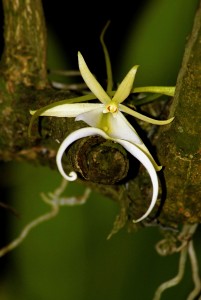 The Ghost Orchid is one of the Everglades’ most rare and endangered plants.
The Ghost Orchid is one of the Everglades’ most rare and endangered plants.
Known in the scientific world as Dendrophylax lindenii, the Ghost Orchid is prized for its delicate, white flower petals. It gets its name from the nocturnal movement of the flower, which resembles a ghost.
Ghost Orchids enjoy conservation protection in Florida, and it’s illegal to tamper with or collect them. As of December 2016, it was believed that only about 2,000 plants remained in the wild. Poaching, as well as human development, continues to threaten its existence.
The Ghost Orchid can be found locally in Big Cypress National Preserve, along with more than 30 other types of orchids.
Visually, the plant appears as a leafless, tangled mass of green roots hugging the trunk of a host tree. It’s often found in deep swamps of cypress, pond apple, and palm trees, and can be distinguished from other orchid varieties by thin white markings on its root system.
The Ghost Orchid requires very specific environmental conditions to grow: high humidity, mild temperatures, shade, and the presence of mycorrhizal fungi. It can also be found in the Bahamas and Cuba, but thrives under a different set of conditions than those in southern Florida.
The Ghost Orchid’s flower blooms in June and July, and it’s pollinated by the giant sphinx moth, which typically visits more than one plant in its nightly travels. The sphinx moth’s tongue easily reaches the plant’s pollen; other insects have difficulty getting to it.
The popularity of Ghost Orchids grew after Susan Orlean’s 1998 book, “The Orchid Thief,” which was later turned into the 2002 film, “Adaptation.” Researchers at the University of Florida in Gainesville recently developed a way to culture the seeds, grow the plants in greenhouses, and re-introduce them into the wild.
Want to go hunting for Ghost Orchids? Captain Mitch’s Airboat Tours in Everglades City, Florida, can show you many of the flora and fauna found in the Everglades. To book a tour, visit our website or call 800-368-0065.






